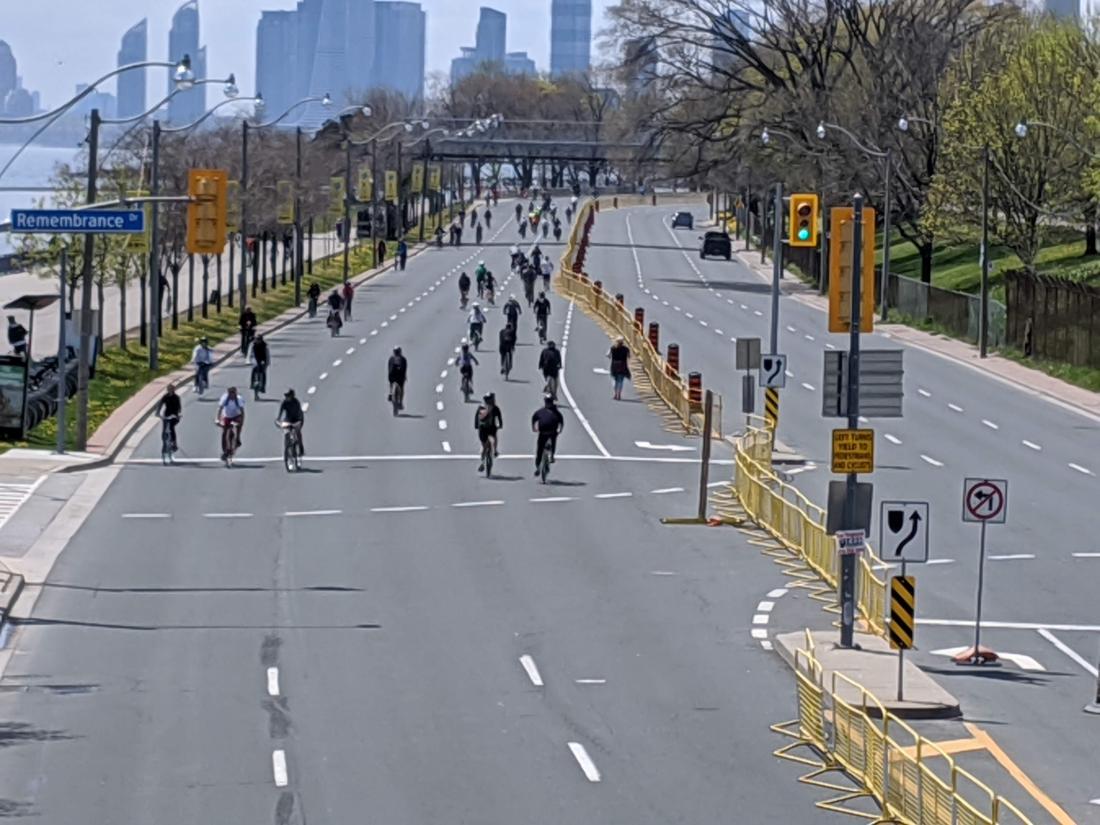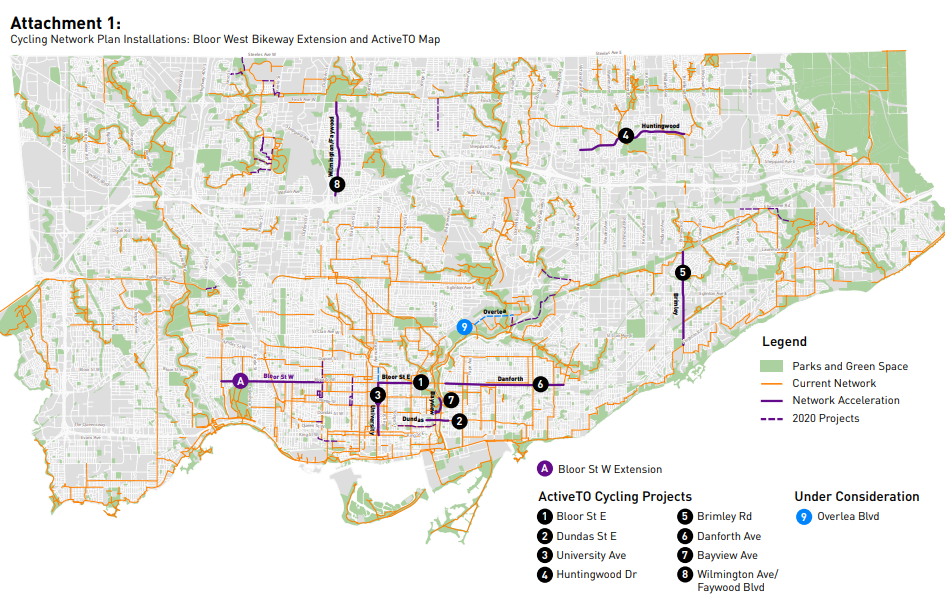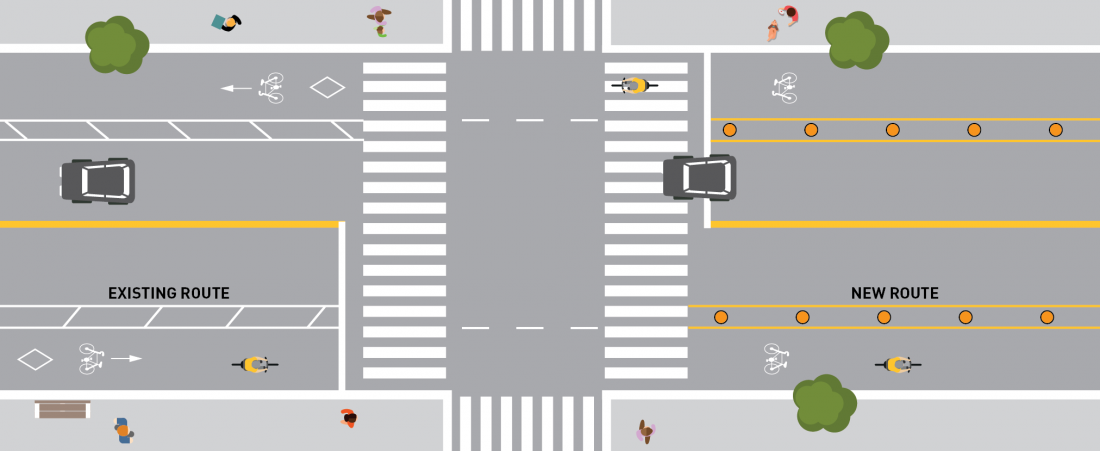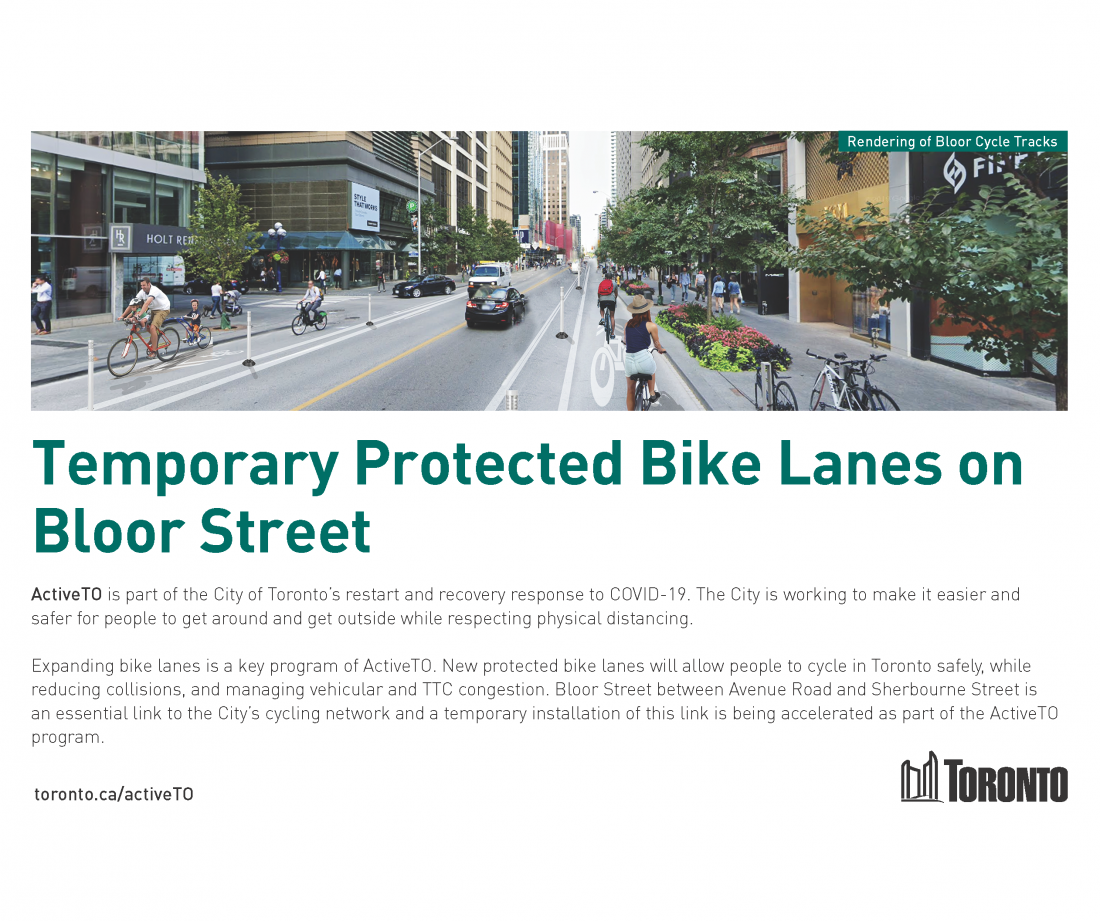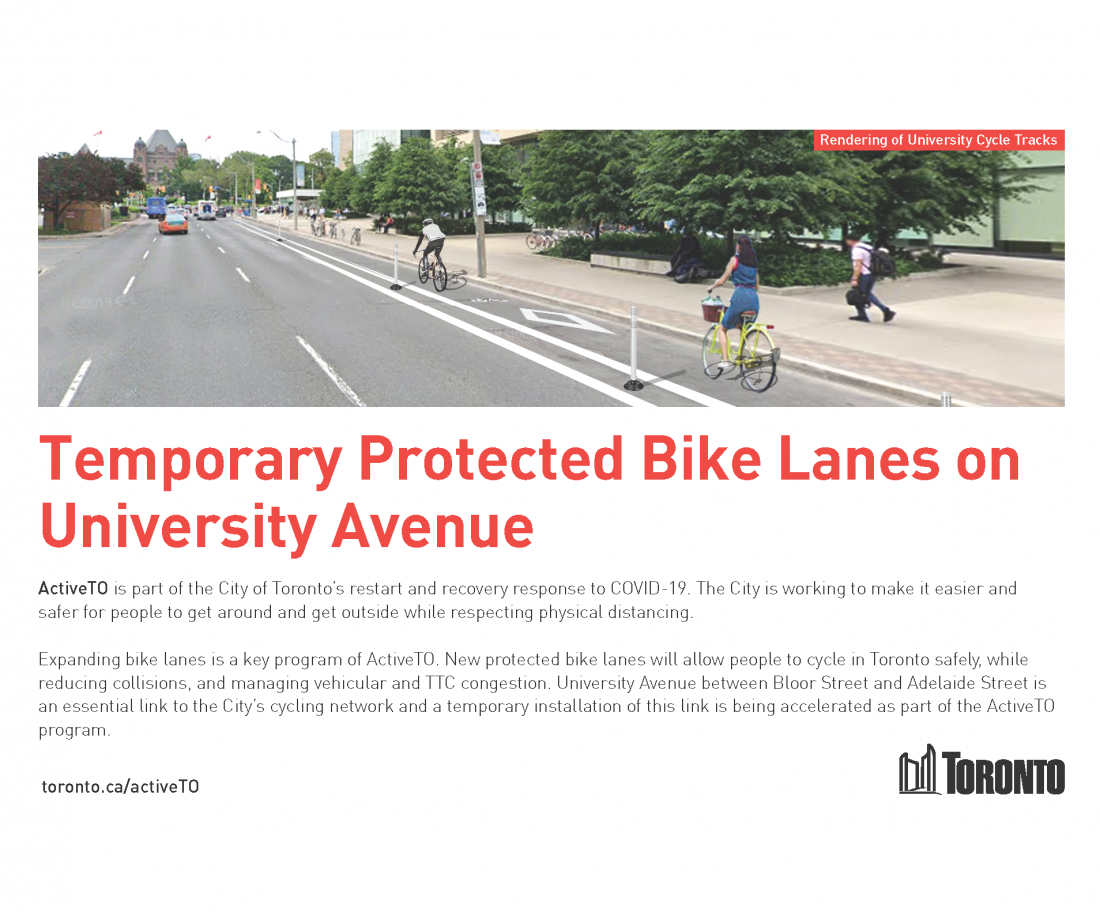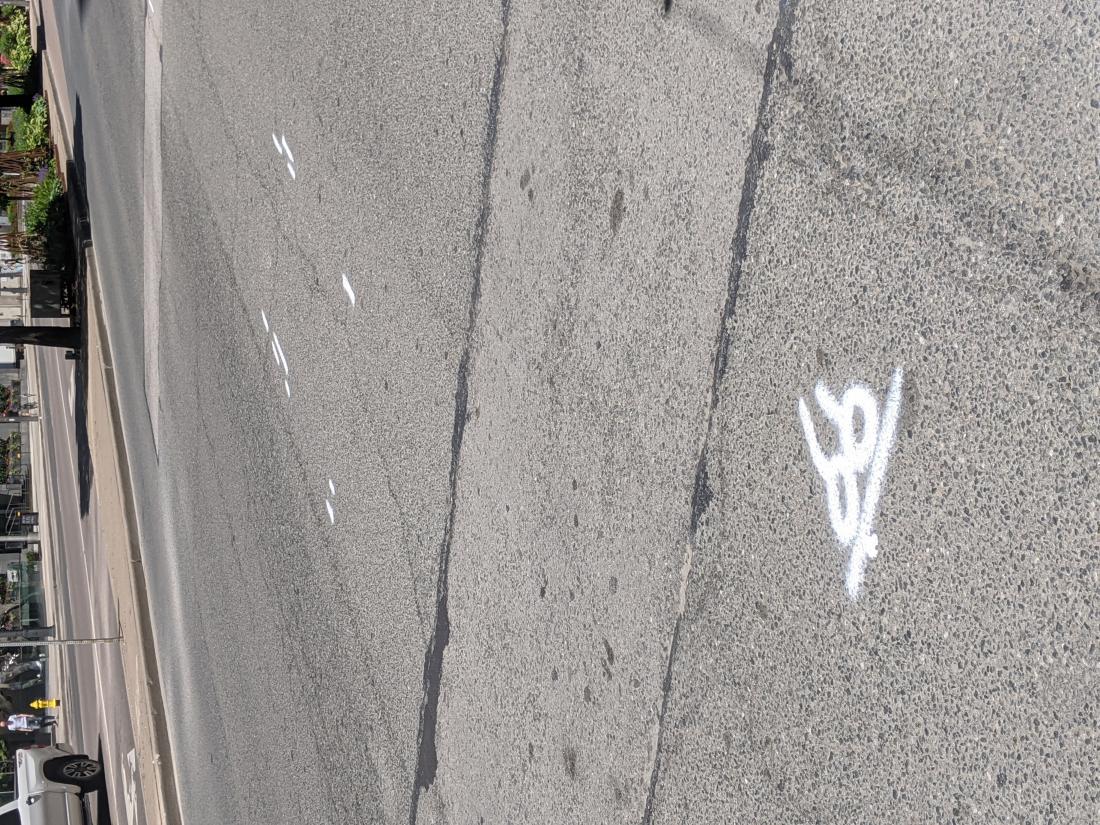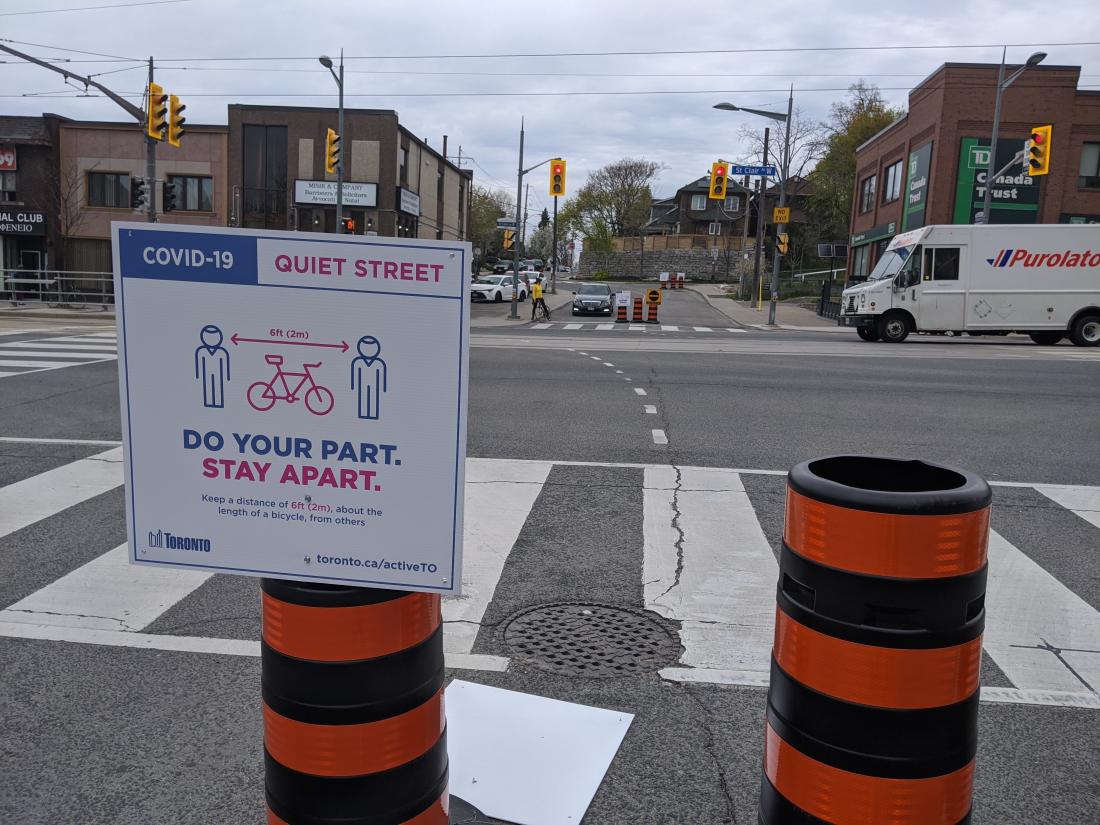
A Month of ActiveTO

Keep in touch! Sign up for email updates to stay in the loop.
Subscribe to our monthly newsletter: The Ring & Post
It has been over a month since ActiveTO was first announced, and we’ve seen much of our recent advocacy work come to fruition. Quiet Streets creating low-pressure active transportation routes to promote recreation while practicing physical distancing began rolling out just days later. Weekend Major Road Closures on Lake Shore Blvd. and Bayview Ave. followed not long after. Then came the big announcement: a historic (for Toronto) package of bike lanes was presented to City Council and we asked you to be loud. You followed through with just shy of 1,300 people writing the Mayor and Council in support of the package of bike lanes.
Your hard work paid off.
Council passed the vote 23-2. Near unanimous support for new bike lanes has made it possible for the City to begin installing the temporary infrastructure just a week after the vote.
We want to take a moment and look back at what we’ve seen from ActiveTO so far, and give you an idea of what it will look like in the future.
Quiet Streets
Winona Dr. Quiet Street at St. Clair Ave.
Quiet Streets have been implemented successfully in other jurisdictions, most notably Oakland’s Safe Streets, but remain a work in progress in Toronto. The City has rolled out 62 km of Quiet Streets, and has partnered with 8-80 Cities to improve rollout and implementation. 8-80 Cities had success in Toronto with last year’s pop-up bike lanes on Danforth and school quiet zones. We remain optimistic that with more improvements and community consultation that Quiet Streets in Toronto can provide connectivity, address short-term gaps in the Cycling Network Plan, and offer the potential to create Quiet Neighbourhoods that prioritize safe streets in the short term and beyond the pandemic.
Major Road Closures
Lake Shore West on opening weekend
Opening parts of Lake Shore Blvd. and Bayview Ave. to people on the weekends has been transformational and played out differently than the Quiet Streets. After adjustments were made following the first weekend to address poor signage and awareness, it has been a resounding success. With the road open to people, the Mayor remarked it was a good time to be a politician because everyone was happy.
The first closures included Lake Shore Blvd. W. and the southern portion of Bayview Ave. and road openings have since expanded to include a portion of Lake Shore Blvd. E. With its most recent expansion the Lake Shore East ActiveTO area runs from Leslie St. to Woodbine Ave., which made it much easier to get from the Beaches to Tommy Thompson Park over the weekend.
We are pushing the city to continue to explore other potential Major Road Closures, especially to help neighborhoods outside the core can safely access outdoor space for physical and mental wellbeing.
Accelerating the Cycling Network Plan
Accelerating the cycling network has been central to our advocacy since the inception of our organization, and our Open Letter to the Office of Recovery and Rebuild recommended the City look at completing the plan within the current term of Council. The proposal to accelerate 40km of new bike lanes this summer, most of them protected, is a crucial first step to building a more equitable cycling network across the city.
Click here to view PDF of map
15 km of projects that were already in the works for 2020 are part of the acceleration, including the Bloor W Extension. New projects for 2020 include 25 km of temporary bike lanes which the city will report back on in 2021. The temporary nature of these bike lanes ensures they can be rolled out quickly and adjusted based on feedback. Cycle Toronto will work the city, community groups, and businesses to ensure the infrastructure is a success so that it can be made permanent.
Cycling routes include:
- A historic cycling victory along Bloor-Danforth:
- Bloor St W: extending the incredibly popular bike lane west 4.5km from Shaw St to Runnymede Rd
- Bloor St E: closing the 1.5 km gap between Avenue Rd and Sherbourne St
- Danforth Ave: 6 km from Broadview Ave to Dawes Rd, the current boundaries of The Danforth Study
- Connections that will deepen our cycling network and create future opportunities to extend routes outside the downtown:
- Dundas St E: 1 km from Sackville St to Broadview Ave, to help connect the Dundas St E bike lanes across the Don Valley Parkway and provide a more convenient connection to Regent Park and the Gerrard St bike lanes
- University Ave: 2+ km from Adelaide St W to Bloor St W, to create a comfortable and safe north-south cycling route in the downtown core to the cluster of hospitals in the Discovery District
- Bayview Ave: 1 km multi-use trail to make it easier to connect downtown and East York via Pottery Road
- Overlea Blvd: under consideration to further connect the bike lanes in Thorncliffe Park and Flemingdon Park
- Projects that will begin the overdue creation of a suburban network:
- Brimley Ave: 4 km from Lawrence Ave to Kingston Rd, to finally create a north-south route in Scarborough
- Huntingwood Dr: 5 km from Victoria Park to Brimley Rd, to begin the first steps of building a cycling network in Scarborough with an east-west route
- Faywood Blvd and Wilmington Ave: 4 km from Finch Ave to Wilson Ave, to better link the Finch Hydro Corridor Trail south to communities and develop a north-south route in North York
The temporary package is a good start and includes a 15 km continuous bikeway on Bloor and Danforth along TTC Line 2 subway between Runnymede and Dawes. However, there are some obvious gaps, including:
- The TTC Line 1 subway along Yonge, the busiest subway in Canada, will not have any relief as there is no bike lane along Yonge proposed
- There is no infrastructure in Midtown
- In the suburbs, none of the TTC’s crowded bus lines have relief
- Many of the City’s wards will see no new infrastructure under this plan despite a lack of cycling infrastructure being a citywide issue
- Etobicoke has no major projects proposed
First Installation: Dundas East
The implementation of the first of these temporary bike lanes began a week after the Council vote with Dundas E installed on Friday, June 5th and provides a good example of what we can expect to see for most of the new lanes.

Photo of Dundas East courtesy of City of Toronto Transportation services
The City’s example of an ActiveTO bike lane
We’re pleased to see the temporary designs include paint and fixed physical separation. Relying on traffic barrels has proven a challenge of CurbTO and many Quiet Streets due to the ease with which bystanders can move them.
Bollards on pavement has been Toronto’s preferred implementation for many of its permanent protected bike lanes, and are still used in many places. Over the past months the City has been upgrading many of its protected bike lanes including along Woodbine, Hoskin, and River, to have concrete barriers with bollards on top. We will work toward upgrading these temporary bikeways as part of the refinement process.
So far, we’re pleased with the speed of installation, and the width of the lanes seen on Dundas St. E. It is our hope that the City will use these or better standards elsewhere in Toronto.
There are going to be growing pains as this infrastructure rolls out quickly. It’s as important as ever to report what is working and what is not. Adjustments will need to be made and the City is planning on making that part of the process. Please contact us so that we can raise issues with the City as they arise.
It’s always a good idea to engage with your councillor and the Mayor to advocate for improvements, as well.
| Find your councillor | Contact the Mayor |
Where is next?
The City provided us with a few mailout pamphlets that give a glimpse of which ActiveTO lanes will be next:
Here are some photos taken on University Ave. on June 17th, 2020.
As you can see, University’s bike lanes have already been outlined on the road. The buffer is to the left of the current lane and the new bike lane will be to the right. Construction may have already begun by the time you read this.
The way we advocate has transformed during COVID-19. We’ve moved quickly to adapt and transform our advocacy, and as we’ve shifted our operations online, many of our usual fundraising activities have been cancelled. If you value the work we do, please join or make a donation. Even $5 a month supports our educational outreach, running (virtual) events and workshops, and ensures you have a strong voice at City Hall.

